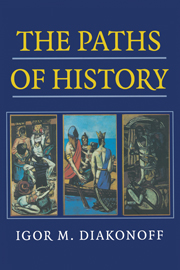Book contents
- Frontmatter
- Contents
- Foreword by Geoffrey Hoskins
- Preface
- Introduction
- 1 First Phase (Primitive)
- 2 Second Phase (Primitive Communal)
- 3 Third Phase (Early Antiquity)
- 4 Fourth Phase (Imperial Antiquity)
- 5 Fifth Phase (the Middle Ages)
- 6 Sixth Phase (the Stable Absolutist Post-Medieval Phase)
- 7 Seventh Phase (Capitalist)
- 8 Eighth Phase (Post-Capitalist)
- Index
1 - First Phase (Primitive)
Published online by Cambridge University Press: 02 December 2009
- Frontmatter
- Contents
- Foreword by Geoffrey Hoskins
- Preface
- Introduction
- 1 First Phase (Primitive)
- 2 Second Phase (Primitive Communal)
- 3 Third Phase (Early Antiquity)
- 4 Fourth Phase (Imperial Antiquity)
- 5 Fifth Phase (the Middle Ages)
- 6 Sixth Phase (the Stable Absolutist Post-Medieval Phase)
- 7 Seventh Phase (Capitalist)
- 8 Eighth Phase (Post-Capitalist)
- Index
Summary
For the earliest periods in the history of Homo sapiens only a technological periodisation is possible: the Palaeolithic period, the Mesolithic period (chiefly attested in the western part of the Eurasian continent), the Neolithic period. The actual life of the Late Palaeolithic man might have been observed in the instance of the aboriginal population of Australia; however, the very imperfect observations date mainly from the time when the societies of the Aboriginals had already been radically disrupted by the mass immigration to Australia from Europe from the second half of the nineteenth century. One of the most interesting pieces of evidence comes from a nearly illiterate Englishman, who was sentenced to transportation to Australia, fled from the colony and lived among the Aboriginals for decades, spending the end of his life in one of the towns of Eastern Australia. He told his story to a chance journalist. Scientific research, however, began only at the very end of the nineteenth century. It might seem that the Palaeolithic state of the Australian Aboriginals, at an epoch when Europe and America had reached the high level of capitalist development, might attest not only to social but even to biological backwardness. This is not the case. The epoch of the class development of mankind occupies no more than 1 or 2 per cent of the existence duration of the species Homo sapiens sapiens. Thus a technological lag of only 2 per cent – let us say a speed of 10.2 seconds instead of 10.0 in a 100 metre run – is sufficient to account for a technological retardation of this scale.
- Type
- Chapter
- Information
- The Paths of History , pp. 10 - 12Publisher: Cambridge University PressPrint publication year: 1999



